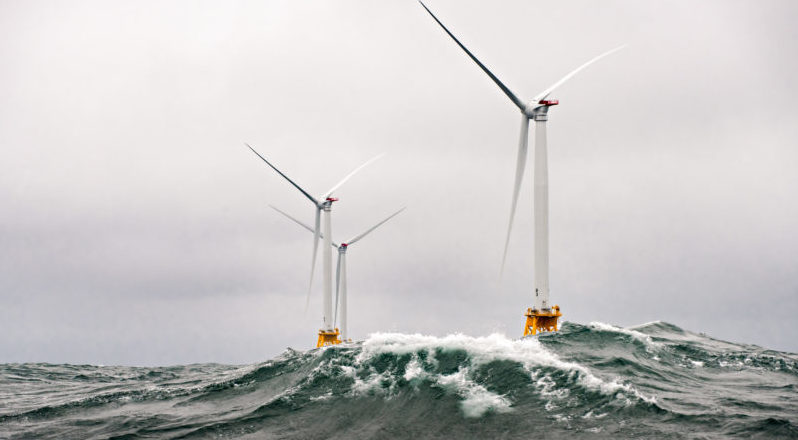The U.S. offshore wind industry is on the verge of starting its first major projects, but needs more coordination among East Coast states and predictability in federal leasing and permitting, advocates said Tuesday at the opening of the International Partnering Forum 2019 in New York City.
New York state’s goal of generating 9 gigawatts of offshore wind power by 2030 “has really helped push the U.S. industry to the tipping point,” said Liz Burdock, president and CEO of the Business Network for Offshore Wind, which is sponsoring the conference with the New York State Energy Research and Development Authority (NYSERDA).
But the industry now faces major challenges, including phase out of the federal tax credit for renewable energy, “capacity issues is our supply chain,” and a lack of coordination among the states that has begun to constrain investment by developers and suppliers, said Burdock.
“The next two to three years are going to be a critical time for the U.S. wind energy,” she added.
In their bids to supply future power to New York and other states, wind developers have pitched to potential for new local jobs in manufacturing, construction and maintenance. But experience in Europe shows staking local claims to benefits can by counter-productive, said Giles Dickson, CEO of WindEurope.
“The level of liberalization and specialization in Europe has been driven from the bottom up,” said Dickson. “We in Europe understand the desire for local jobs,” but in France where those have been mandated the industry’s costs are highest, he said.
“If you want to have local jobs and low costs, it’s best to leave it to the market,” he said.
Europe has still more needs for cooperation and commonality, from aviation warning lights on turbine tower, and moving toward better electric grid connections and coordinating energy auctions, Dickson added: “We have to collaborate and align the rules whenever we can.”

BOEM acting director Walter Cruickshank says his agency is reviewing three construction and operation plans submitted by offshore wind developers. Kirk Moore photo
The federal Bureau of Ocean Energy Management is reviewing three construction and operation plans from East Coast offshore wind energy developers, and expects to have more in hand this year, said Walter Cruickshank, BOEM’s acting director.
By the end of 2019, construction could begin on the first turbine array in federal waters with Vineyard Wind's 800 MW project off Massachusetts, with more coming through the 2020s on 15 leased areas of nearly 1.7 million acres, said Cruickshank.
The agency is preparing to do environmental assessments of potential wind energy areas (WEAs) in the New York Bight, a heavily trafficked arm of the Atlantic between the New York and New Jersey coastlines. It is a particular challenge, as a very busy area with a lot of uses by fishing and shipping interests and environmental considerations, so the process is taking time, Cruickshank noted.
New York officials would like it to move faster.
“We are eager for that process to move forward,” said Alicia Barton, CEO of the NYSERDA state energy agency, during a panel discussion on the potential for renewable energy to supply most new power in the coming decades.
“Predictable and transparent” leasing and permitting processes will be key, said Christer af Geijerstam, president of Equinor Wind USA, which has 5 GW in its planned offshore wind portfolio, including the Empire Wind project on a 79,350-acre lease close to the New York Harbor approaches.

A model of a floating wind energy turbine at the IPF19 conference in New York City. Kirk Moore photo
“We need predictability on that,” he said. “That fosters investment from us (developers) and the tier 1 suppliers.” But the industry can’t lose sight of other maritime users’ needs and the potential conflicts over new WEAs, he added.
Cruickshank reported recent progress on that front, with an agreement between BOEM, the National Oceanic and Atmospheric Administration and the Responsible Offshore Development Alliance, a coalition of commercial fishing and seafood industry groups.
The pact seeks better cooperation between RODA and the agencies on bringing fishermen’s knowledge and expertise into the wind energy planning process. The group has also arrived at similar formal agreements with Ørsted and Equinor.
The major challenges to a growing offshore energy industry are not technical in the construction and operation of turbines, but in getting broad cooperation to build an effective network, said Ditlev Engel, CEO of DNV GL, and energy and maritime consulting group.
“From a technical point of view, it can be done. But people have to work together,” he said.
Other needs are port facilities big enough to handle components for future turbines and their towers that by the 2020s will be taller and more powerful. Like the U.S. shipbuilding industry, the offshore wind industry could be constrained by workforce shortages.
There will be needs for more welders and other skilled workers, and developers will need to reach out to unions, vocational-technical schools and colleges to attract and develop talent, speakers said. Ørsted will contribute $10 million in seed money for workforce training at Suffolk County Community College in New York to support its projects east of Long Island, said Sunny Gupta, head of new market development for the company.
On Monday BOEM hosted the first Global Offshore Wind Regulators Forum alongside the New York event, hosting officials from Australia, Canada, Denmark, Germany, The Netherlands, Norway, Scotland, and the United Kingdom. Cruickshank said the gathering aimed to share best practices and lessons learned, with the next annual meeting to be held in Denmark.
Later that day Cruickshank and Netherlands Consul General Dolph Hogewoning signed a memorandum of understanding to strengthen U.S-Dutch bilateral cooperation on offshore wind.





